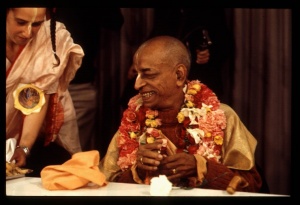CC Adi 13.89: Difference between revisions
No edit summary |
(Vanibot #0054 edit - transform synonyms into clickable links, which search similar occurrences) |
||
| Line 17: | Line 17: | ||
<div class="synonyms"> | <div class="synonyms"> | ||
''caudda-śata sāta-śake'' | ''[//vanipedia.org/wiki/Special:VaniSearch?s=caudda&tab=syno_o&ds=1 caudda]-[//vanipedia.org/wiki/Special:VaniSearch?s=śata&tab=syno_o&ds=1 śata] [//vanipedia.org/wiki/Special:VaniSearch?s=sāta&tab=syno_o&ds=1 sāta]-[//vanipedia.org/wiki/Special:VaniSearch?s=śake&tab=syno_o&ds=1 śake]'' — in 1407 of the Śaka Era (A.D. 1486); ''[//vanipedia.org/wiki/Special:VaniSearch?s=māsa&tab=syno_o&ds=1 māsa]'' — month; ''[//vanipedia.org/wiki/Special:VaniSearch?s=ye&tab=syno_o&ds=1 ye]'' — which; ''[//vanipedia.org/wiki/Special:VaniSearch?s=phālguna&tab=syno_o&ds=1 phālguna]'' — ''Phālguna; ''[//vanipedia.org/wiki/Special:VaniSearch?s=paurṇamāsīra&tab=syno_o&ds=1 paurṇamāsīra]'' — of the full-moon day; ''[//vanipedia.org/wiki/Special:VaniSearch?s=sandhyā&tab=syno_o&ds=1 sandhyā]-[//vanipedia.org/wiki/Special:VaniSearch?s=kāle&tab=syno_o&ds=1 kāle]'' — in the evening; ''[//vanipedia.org/wiki/Special:VaniSearch?s=haile&tab=syno_o&ds=1 haile]'' — there was; ''[//vanipedia.org/wiki/Special:VaniSearch?s=śubha&tab=syno_o&ds=1 śubha]-[//vanipedia.org/wiki/Special:VaniSearch?s=kṣaṇa&tab=syno_o&ds=1 kṣaṇa]'' — an auspicious moment. | ||
</div> | </div> | ||
Latest revision as of 18:26, 19 February 2024

A.C. Bhaktivedanta Swami Prabhupada
TEXT 89
- caudda-śata sāta-śake māsa ye phālguna
- paurṇamāsīra sandhyā-kāle haile śubha-kṣaṇa
SYNONYMS
caudda-śata sāta-śake — in 1407 of the Śaka Era (A.D. 1486); māsa — month; ye — which; phālguna — Phālguna; paurṇamāsīra — of the full-moon day; sandhyā-kāle — in the evening; haile — there was; śubha-kṣaṇa — an auspicious moment.
TRANSLATION
Thus in the year 1407 of the Śaka Era [A.D. 1486], in the month of Phālguna [February-March], in the evening of the full-moon day, the desired auspicious moment arrived.
PURPORT
Śrīla Bhaktivinoda Ṭhākura, in his Amṛta-pravāha-bhāṣya, has presented the horoscope of Śrī Caitanya Mahāprabhu as follows:
- śaka 1407/10/22/28/45
- dinam
- 7 11 8
- 15 54 38
- 40 37 40
- 13 6 23
The explanation of the horoscope given by Bhaktivinoda Ṭhākura is that at the time of the birth of Lord Caitanya Mahāprabhu the planets were situated as follows: Śukra (Venus) was in Meṣa-rāśi (Aries) and the nakṣatra (lunar mansion) of Aśvinī; Ketu (the ninth planet) was in Siṁha-rāśi (Leo) and Uttaraphalgunī; Candra (the moon) was in Pūrvaphalgunī (the eleventh lunar mansion); Śani (Saturn) was in Vṛścika-rāśi (Scorpio) and Jyeṣthā; Bṛhaspati (Jupiter) was in Dhanu-rāśi (Sagittarius) and Pūrvāṣāḍhā; Maṅgala (Mars) was in Makara-rāśi (Capricorn) and Śravaṇā; Ravi (the sun) was in Kumbha-rāśi (Aquarius) and Pūrvabhādrapāda; Rāhu was in Pūrvabhādrapāda; and Budha (Mercury) was in Mīna-rāśi (Pisces) and Uttarabhādrapāda. The lagna was Siṁha.